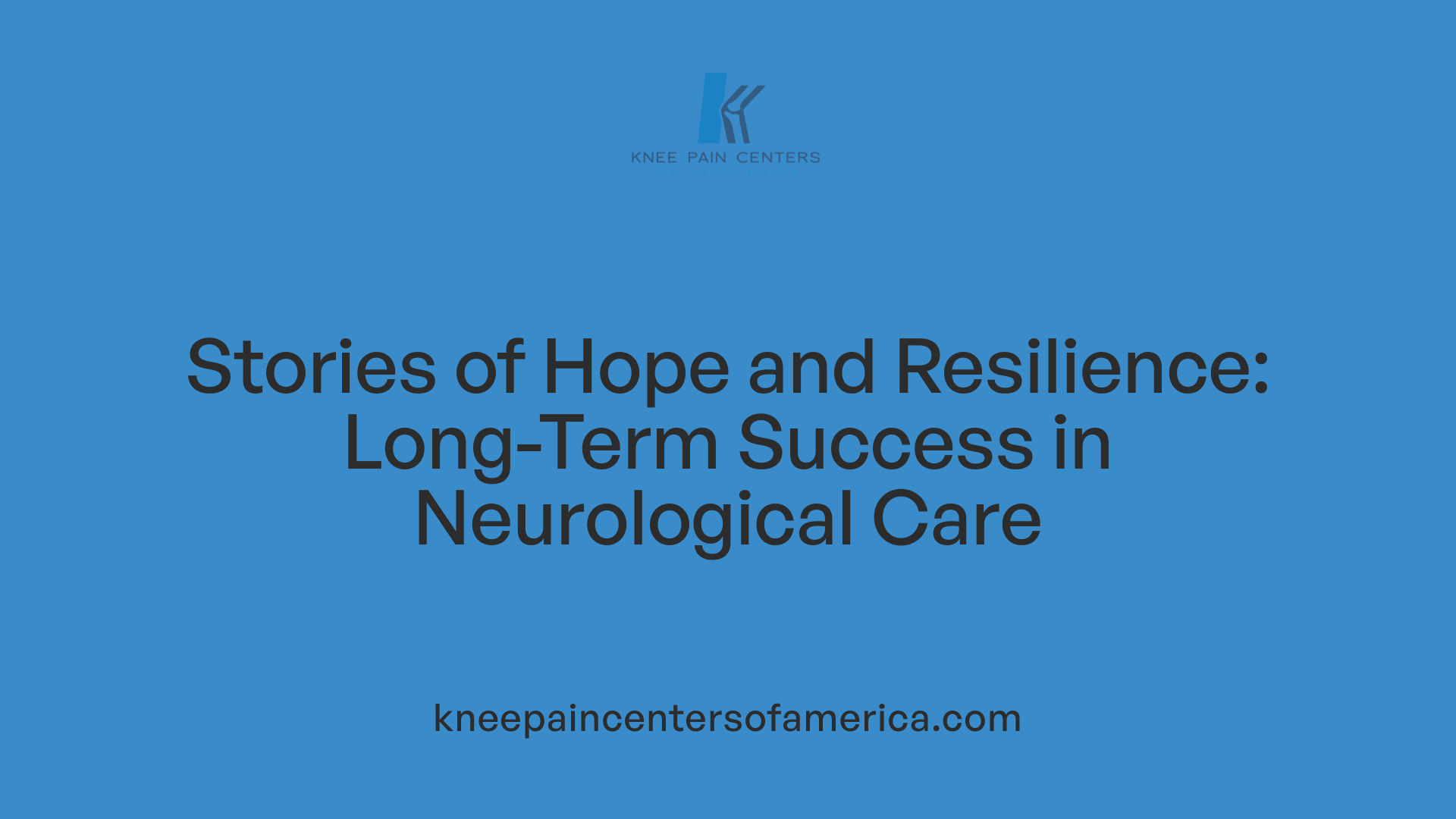Unveiling Inspiring Patient Journeys
Success stories stemming from GAE (Gene and Advanced Therapies) showcase remarkable recoveries and enhanced quality of life for patients battling complex conditions such as epilepsy, cancer, and genetic disorders. This article explores real-life experiences, recent breakthroughs, and the promising future of personalized medicine driven by GAE advancements.
Personal Triumphs Over Neurological Conditions
What are some personal stories of patients living with epilepsy or other neurological conditions?
Individual accounts shed light on the varied experiences faced by those with epilepsy and other neurological disorders. Many patients discover their conditions early, often through symptoms that disrupt daily life, like recurrent seizures or unusual neurological episodes. For some, these diagnoses mark the beginning of long journeys filled with medication trials, lifestyle adjustments, and advocacy efforts.
One compelling story involves a patient who, after years of struggling with resistant epilepsy, underwent a successful brain surgery in 2017 and has remained seizure-free ever since. Such surgical interventions can drastically improve life quality, helping individuals regain independence and pursue ambitions that previous seizures had hindered.
Patients across different ages and backgrounds share their resilience—children who learn to manage their conditions, adults who return to careers, and elderly individuals advocating for awareness and research.
Personal stories often emphasize the emotional toll of living with a neurological disorder, but also highlight the hope that comes from medical advances. From cutting-edge diagnostics like EEG and MEG that localize seizure foci, to innovative surgical techniques, these tools have been pivotal in transforming lives.
In addition, healthcare professionals with personal connections to epilepsy, such as Dr. Mark Callow, exemplify how personal experience can inspire compassionate care and advocacy. Their stories motivate ongoing research, support networks, and new treatments, illustrating that progress isn’t just clinical but deeply human.
The collective narrative of resilience and hope demonstrates how advancements in medicine and patient advocacy continue to improve outcomes for individuals living with epilepsy and other neurological conditions, fostering a community that believes in better days ahead.
Groundbreaking Advances in Gene and Immunotherapy

What advances and breakthroughs have been made in gene therapy and immunotherapy?
Recent years have seen remarkable progress in the fields of gene therapy and immunotherapy, revolutionizing treatment options for a range of diseases. Gene therapy has achieved significant milestones, including the approval of treatments like Spinraza (nusinersen) for spinal muscular atrophy (SMA), a condition previously lacking effective options. This therapy helps motor neurons produce essential proteins, greatly extending lives and enhancing motor functions.
Additionally, gene therapy techniques now target inherited and acquired disorders. For example, Luxturna, approved by the FDA in 2017, treats heritable retinal dystrophy caused by RPE65 gene mutations. It involves delivering a functional copy of the defective gene directly into the retina, resulting in significant vision improvements for patients. Despite its high cost—around $425,000 per injection—most patients gain access through various programs. Patients treated with Luxturna have reported seeing stars for the first time, illustrating substantial functional recovery.
Progress extends to the use of cutting-edge molecular technologies. Technologies such as CRISPR/Cas9, TALENs, and zinc finger nucleases (ZFN) have dramatically improved the precision of gene editing. These tools enable the targeted correction of genetic mutations in different tissues, efficiently and safely. For instance, at Children’s Hospital of Philadelphia, CRISPR-based therapies have successfully treated infants with rare genetic disorders like CPS1 deficiency. The therapy, administered via lipid nanoparticles targeting the liver, corrected faulty enzymes and resulted in minimal side effects while improving health markers.
In the realm of cancer, immunotherapy has made unprecedented strides. Immune checkpoint inhibitors like ipilimumab and pembrolizumab block proteins that cancer cells use to evade immune attacks, effectively restoring immune surveillance. These drugs have transformed the treatment of melanoma, lung cancer, and other solid tumors.
Equally transformative is the development of CAR T-cell therapy, where a patient's immune cells are genetically engineered to recognize and attack cancer. Since the first successful cases, patients like Emily Whitehead and Tori Lee, both benefiting from CAR T treatments, now enjoy over a decade free of cancer. These therapies have shown remission rates around 85% in blood cancers, offering hope to patients with otherwise limited options.
Another frontier is the use of oncolytic viruses that infect and destroy tumor cells while stimulating immune responses. Combined with other treatments, these viral therapies are under active research, promising further expansion of the scope and success rates of cancer immunotherapy.
Advances also include understanding immune evasion mechanisms within tumors, identifying predictive biomarkers for therapy response, and developing combination strategies to maximize effectiveness. Novel delivery approaches utilizing nanotechnology enhance the precision and reduce side effects of these treatments.
Overall, the integration of gene editing tools, improved vector design, and immune-modulating therapies have doubled or tripled success stories across multiple disease categories. As ongoing clinical trials continue to demonstrate safety and efficacy, these revolutionary treatments are paving the way for personalized, highly effective medicine. The expanding scope of gene and immunotherapy promises a future where previously incurable conditions are now manageable or curable, radically transforming patient outcomes.
| Technology / Approach | Disease Focus | Recent Developments | Impact on Treatment |
|---|---|---|---|
| Gene Therapy (e.g., Spinraza, Luxturna) | Genetic & Rare Diseases | FDA approvals, functional improvements | Expanding access, life-extending therapies |
| Molecular Techniques (CRISPR, TALEN, ZFN) | Genetic editing | Successful infant treatments, targeted correction | Enhanced precision, safety, and efficacy |
| Immune Checkpoint Inhibitors | Cancer | Approval of ipilimumab, pembrolizumab | Reshaping cancer immune management |
| CAR T-cell Therapy | Hematologic & some solid tumors | Over 130,000 patients treated globally | High remission rates, long-term survival |
| Oncolytic Viruses | Various cancers | Under clinical trials | Potential for combination therapies with immunotherapies |
| Delivery Technologies | Multiple diseases | Use of nanotechnology and vectors | Better targeting, fewer side effects |
This synergy of innovative techniques and molecular understanding continues to transform medicine, guiding us toward increasingly personalized and effective treatments for the future.
Success Stories of GAE in Pain Relief and Physical Restoration

What are some successful stories of patients who have undergone GAE treatments?
Numerous patients have shared inspiring experiences after receiving GAE (Geniculate Artery Embolization) treatments. These stories highlight how the procedure can significantly alleviate chronic pain and restore mobility.
One such case involves Sarah, a 55-year-old teacher who suffered from persistent knee pain. Within just a week of treatment, she reported a remarkable reduction in discomfort, leading to a noticeable improvement in her quality of life. Her ability to perform daily activities and engage in social outings greatly enhanced her well-being.
Another inspiring example is John, a 62-year-old man who struggled with mobility issues due to severe joint pain. Post-GAE, he regained sufficient strength and flexibility to walk long distances. Today, John happily plays golf on weekends, demonstrating how GAE can help patients return to their preferred activities.
Long-term follow-up data supports these positive outcomes. Patients like Maria and Tom have experienced sustained relief for two or more years after their procedures. Many, avoiding more invasive surgeries like knee replacements, enjoy ongoing benefits that improve their independence and reduce reliance on pain medications.
There are also notable cases of older adults thriving post-treatment. Patrick Schruben, an 80-year-old retiree, underwent both GAE and EAE (Endovascular Arterial Embolization). The procedures allowed him to resume active lifestyles—including playing pickleball and traveling internationally—proving that age does not limit the potential benefits of GAE.
Clinical research underscores these testimonials, confirming that GAE is a safe, minimally invasive option with durable pain relief. Patients typically report lasting improvements in pain levels and functional ability, often over multiple years.
| Patient Name | Age | Main Benefit | Duration of Relief | Lifestyle Impact |
|---|---|---|---|---|
| Sarah | 55 | Pain reduction | 1+ year | Increased daily activity |
| John | 62 | Restored mobility | 2+ years | Played golf, long walks |
| Maria | 68 | Sustained pain relief | 3+ years | Gardening, traveling |
| Patrick | 80 | Return to active hobbies | 2+ years | Pickleball, travel |
These stories serve to inspire many considering GAE, demonstrating its potential to transform lives by relieving pain and restoring the ability to enjoy an active lifestyle.
Gene Therapy for Genetic Disorders: From Cure to Hope
How has gene therapy been used to treat genetic conditions such as the bubble boy disease?
Gene therapy has become a transformative approach for treating inherited genetic disorders, including severe combined immunodeficiency (SCID), famously known as Bubble Boy Disease. This condition results from mutations in genes crucial for immune system development, leaving patients highly vulnerable to infections.
At UCSF, innovative gene therapy techniques have been successfully applied to children with Artemis-SCID, a rare form of SCID. The treatment involves extracting the patient’s own stem cells, correcting the defective gene responsible for immune dysfunction—specifically, Artemis gene—using viral vectors, and then reintroducing these healthy cells into the patient’s body. This process effectively restores normal immune function, allowing children to develop immunity and lead healthier lives.
Similarly, at St. Jude Children's Research Hospital, researchers used a lentiviral vector—a type of virus modified to deliver therapeutic genes safely—to insert a functional copy of the IL2RG gene into the bone marrow stem cells of infants with SCID-X1. This genetic correction prompted a rapid and robust development of T cells, B cells, and natural killer (NK) cells, which are essential for immune defense. Patients treated with this method showed significant improvement, with some achieving immune responses comparable to those of healthy individuals.
The impact of these therapies has been profound. Children who previously depended on protective isolation can now live open, healthier lives, significantly reducing risks of infections. Importantly, gene therapy offers an alternative to traditional bone marrow transplants, which require a closely matched donor and carry risks of rejection and graft-versus-host disease.
Overall, gene therapy for conditions like Bubble Boy Disease exemplifies how genetic corrections can address the root cause of disease. By replacing or repairing faulty genes, these treatments correct the underlying genetic defects, leading to sustained health improvements.
| Disease | Treatment Approach | Viral Vector Used | Outcomes | Additional Notes |
|---|---|---|---|---|
| Artemis-SCID | Gene correction in stem cells | Autologous, viral vector | Restored immune function | Developed at UCSF |
| SCID-X1 | Lentiviral vector gene insertion | Lentivirus | Normal immune cell development | Treated at St. Jude |
The progress in gene therapy not only provides new hope for current patients but also paves the way for treating many other genetic disorders in the future.
Is Gene Therapy a Cure for Cancer?
What is the potential of gene therapy in cancer treatment?
Gene therapy offers an exciting potential to revolutionize how we treat cancer. It aims to target cancer cells directly by modifying genetic material, boosting the body's immune response, and correcting genetic mutations that promote tumor growth. Researchers are exploring a variety of approaches, including immunotherapy, oncolytic viruses, and gene transfer techniques.
In recent years, some therapies like CAR T-cell treatment have gained FDA approval for certain blood cancers, signaling significant progress in this field. These therapies involve programming a patient’s immune cells to recognize and attack cancer cells more effectively. Early clinical results are promising, showing improved remission rates and increased survival chances.
What are the challenges faced by gene therapy in fighting cancer?
Despite its promise, gene therapy faces several hurdles. Delivering the therapy precisely to tumor sites without affecting healthy tissue remains challenging. Immune reactions to the therapy can also limit effectiveness and cause side effects. Additionally, the genetic diversity within tumors (tumor heterogeneity) makes it difficult to develop a one-size-fits-all treatment.
Scientists are actively working to overcome these obstacles by developing targeted delivery systems, refining gene editing techniques, and tailoring treatments to individual genetic profiles. These efforts aim to improve the safety, specificity, and overall success of gene therapies.
Are there ongoing advancements and what is the outlook?
Research into gene therapy for cancer is progressing rapidly. Clinical trials continue to test innovative methods such as gene transfer to boost immune responses or induce cancer cell death. Some experimental approaches aim to make tumors more sensitive to existing treatments, potentially enhancing their effectiveness.
While gene therapy is not yet a universal cure for cancer, it remains one of the most promising frontiers. The ongoing development and early successes suggest that, in the future, it could become a powerful tool either alone or in combination with traditional therapies.
| Therapy Type | Current Status | Specific Target | Potential Impact |
|---|---|---|---|
| CAR T-cell | FDA-approved for certain blood cancers | Genetic modification of immune cells | Increased remission rates |
| Oncolytic viruses | Under research | Virus designed to selectively infect and kill tumor cells | Tumor reduction and immune activation |
| Gene transfer | Clinical trials ongoing | Genetic correction within tumor cells | Improved sensitivity to treatments |
| Personalized gene editing | Early stages | Tailored to individual's tumor genetics | Potential for highly specific treatments |
This table summarizes some of the main types of gene therapies currently in development or approved for cancer treatment, highlighting their targets and impact.
Understanding the Role of Nutritional and Cellular Factors in Epilepsy and Autism
What are some personal stories of patients living with epilepsy or other neurological conditions?
Personal stories from individuals living with epilepsy shed light on the wide range of experiences faced by patients. These narratives include those of children, teens, and adults battling different forms of epilepsy—be it lifelong conditions, genetic mutations, or rare syndromes such as Doose syndrome.
Many stories highlight the profound impact of epilepsy on daily life, from managing seizures to pursuing education and careers. Some patients have found hope through surgical interventions; for instance, a participant who underwent brain surgery in 2017 has been seizure-free ever since, dramatically improving their quality of life.
These personal accounts often discuss the emotional resilience required to cope with a chronic condition. They also emphasize the significance of ongoing research and advocacy, fueling hope for potential cures and better treatments. The diversity of backgrounds and ages among these individuals underscores that epilepsy affects everyone, and their stories provide motivation for continued medical advancement.
This collection of narratives illustrates not only the struggles but also the incredible resilience of those affected by neurological disorders. Their stories serve to raise awareness and foster a sense of community, inspiring hope that future therapies may eradicate seizures and restore normalcy.
How deficiencies in nutrients or cellular processes can cause symptoms
Emerging research suggests that some neurological conditions, including epilepsy and autism, may stem from underlying issues in cellular function or nutritional deficiencies.
For example, deficiencies in certain vitamins, minerals, or cellular processes can impair brain function and trigger seizures or behavioral symptoms. Cerebral folate deficiency (CFD) is a notable example, where low levels of folate in the brain can cause seizures, developmental delays, and autism-like behaviors.
The case of a boy diagnosed with myoclonic epilepsy of infancy (MEI) and high-functioning autism highlights this connection. Despite trying multiple medications—such as Depakote, Onfi, Keppra, Lamictal, and Zonegran—with limited success, his condition improved significantly after treatment with leucovorin, a form of folate. The administration of leucovorin reduced his seizures from 30-50 daily to near zero, and his speech and behavior also improved markedly.
This case exemplifies how deficiencies in nutrients or the disruption of cellular processes can contribute to neurological symptoms. It underscores the importance of understanding individual biochemical profiles in managing conditions like epilepsy and autism.
What is the potential of leucovorin and other nutrients in treating some cases?
Leucovorin, a synthetic form of folate, has shown promising results in treating certain epilepsies linked to nutrient deficiencies. In the case mentioned, leucovorin supplementation led to dramatic reductions in seizure frequency and behavioral improvements, including speech clarity, singing, and calmer demeanor.
Research indicates that some cases of epilepsy and autism may be caused or exacerbated by cellular or metabolic deficiencies. Targeted nutrient therapy, like leucovorin, offers a personalized approach to management, especially when conventional medications have limited effectiveness.
Beyond leucovorin, other nutrients such as vitamin B6, magnesium, and omega-3 fatty acids are being studied for their neuroprotective and stabilizing effects. Therapies focusing on correcting metabolic imbalances hold promise for alleviating symptoms and potentially addressing root causes.
In summary, personalized nutritional therapy can play a crucial role in managing complex neurological conditions. Ongoing research and case studies reinforce the importance of considering cellular health and nutrients as part of comprehensive treatment plans, offering renewed hope for patients with resistant or atypical epilepsy and autism.
Overview of Related Topics
To better understand the progress and potential in neurological condition management, consider the following overview:
| Condition | Example Treatment | Notable Results | Additional Notes |
|---|---|---|---|
| Epilepsy | Leucovorin, Surgery | Seizure reduction, improved behavior | Nutritional and surgical options |
| Autism | Nutritional therapy | Behavioral improvements | Focus on nutrients like folate |
| Rare Genetic Disorders | CRISPR gene editing | Symptom reduction, increased lifespan | Personalized medicine |
| Multiple Sclerosis | B cell targeted drugs | Slowed progression, prolonged disability-free years | New genetic understanding |
These stories and advances highlight a thriving landscape of research, clinical innovation, and personalized medicine, all aiming to improve lives affected by neurological disorders.
Innovations in Pediatric Surgery and Life-Saving Interventions
What are some personal stories of patients living with epilepsy or other neurological conditions?
Personal accounts from individuals managing epilepsy and neurological disorders reveal remarkable resilience and hope. Many share experiences of ongoing struggles with seizures—ranging from lifelong conditions to rare syndromes like Doose syndrome—and their journeys toward diagnosis, treatment, and, in some cases, surgical relief. These stories illustrate how epilepsy can affect personal independence, careers, and social relationships, highlighting both the challenges faced and the victories achieved.
Healthcare institutions like UCSF emphasize advanced pediatric neurosurgical techniques and have contributed significant breakthroughs in treatment. Among these, infants undergoing life-saving surgeries for congenital conditions exemplify how surgical innovation can be transformative. These procedures include repair of congenital diaphragmatic hernia, critical fetal interventions such as laser treatments for twin-to-twin transfusion syndrome (TTTS), and intricate brain surgeries to address malformations or tumors.
Examples of pediatric surgeries at UCSF
UCSF’s pediatric surgical program has successfully performed numerous complex operations, often saving lives and significantly improving prognosis. Notable procedures include:
- Fetal interventions for twin-to-twin transfusion syndrome: Laser surgery to correct blood vessel abnormalities in the womb has resulted in healthy, fully developed twins.
- Surgical repairs for congenital diaphragmatic hernia: These life-saving operations enable newborns with lung compression to breathe more easily post-surgery.
- Brain tumor and malformation surgeries: Pediatric neurosurgery at UCSF has successfully treated children with brain cysts, AVMs, and other neurological issues, leading to better neurological outcomes.
- Cardiac interventions: Procedures like support for hypoplastic left heart syndrome and placement of pacemakers have drastically improved survival rates.
Each successful case emphasizes how early, specialized, and innovative surgery can turn critical conditions into manageable health issues.
Examples of life-saving procedures for infants and children
Many infants and children have benefited from pioneering interventions, which have changed what was once thought impossible. For instance:
- Minimally invasive procedures for congenital heart defects: Innovative cardiac surgeries allow children with HLHS and other conditions to thrive.
- Stem and cellular therapies: For conditions like severe pulmonary hypertension, advanced pediatric treatment options now include responsive medication and, at times, lung transplants.
- Fetal surgeries: Fetal laser therapy for TTTS enables severe twin complications to be resolved prenatally, reducing lifelong disability risks.
- Neurosurgical interventions: Correcting birth-related brain injuries or malformations, these procedures help prevent lifelong disabilities.
Successful outcomes and improved prognosis
The results of these advanced surgical techniques have been impressive. Many children now achieve into adolescence and adulthood with minimal disability or are completely cured. For example:
- Children with congenital conditions like hypoplastic left heart syndrome often survive to adulthood thanks to staged surgical repairs.
- Infants with brain malformations successfully undergo tumor removal or AVM embolization, leading to restored neurological function.
- Fetal interventions have significantly increased survival rates for conditions like TTTS.
These successes showcase the remarkable progress in pediatric medicine, demonstrating how innovative surgeries can greatly improve children's health and future prospects.
Hope and Inspiration: Long-term Outcomes and Patient Resilience

What are some successful stories of patients who have undergone GAE treatments?
Several heartfelt stories exemplify the positive long-term outcomes of GAE (Geniculate Artery Embolization) treatments. For instance, Sarah, a 55-year-old teacher, suffered from chronic knee pain that severely limited her daily activities. After undergoing GAE, she experienced substantial pain relief within just one week, which significantly improved her quality of life. Similarly, John, aged 62, had long struggled with mobility issues; following his GAE procedure, he regained the ability to walk long distances and has returned to playing golf regularly. These stories underscore how GAE can restore physical function and independence.
Long-term data shows that many patients enjoy relief lasting two years or more after treatment. Maria and Tom are among those who avoided the need for invasive knee replacement surgery, with their pain managed effectively through GAE. Their sustained relief highlights the durability of the procedure.
Another compelling example is Patrick Schruben, an 80-year-old who underwent both GAE and EAE (Embolization of the external artery), which allowed him to resume active pursuits such as playing pickleball and traveling internationally. His story inspires older adults showing that age is not a barrier to regaining an active lifestyle.
Overall, clinical studies and patient testimonials confirm that GAE is a minimally invasive treatment that offers lasting pain relief and functional improvement. Patients often regain mobility, reduce reliance on pain medications, and experience better overall wellbeing.
This collection of patient stories illustrates resilience and hope, demonstrating that even chronic pain conditions can have positive long-term outcomes with innovative treatments like GAE. These narratives not only motivate those considering the procedure but also confirm that medical advancements continue to transform lives.
| Patient Name | Age | Treatment Outcome | Duration of Relief | Personal Impact | Additional Details |
|---|---|---|---|---|---|
| Sarah | 55 | Significant pain relief | 2+ years | Improved quality of life | Returned to teaching, less reliance on pain meds |
| John | 62 | Regained mobility | 2+ years | Active lifestyle, resumed golf | Can walk long distances comfortably |
| Maria | Older | Avoided knee surgery | 2+ years | Managed pain effectively | No further surgical intervention needed |
| Patrick | 80 | Resumed active pursuits | 3+ years | Enjoys travel and recreational sports | Participates in pickleball and international trips |
This wealth of success stories underscores the promising future of GAE as a durable, safe, and minimally invasive option for patients seeking relief and a return to active living. Continued research and patient sharing foster hope and exemplify resilience across different age groups and backgrounds.
The Future of Personalized Medicine and Patient Hope
What advances and breakthroughs have been made in gene therapy and immunotherapy?
Recent progress in gene therapy and immunotherapy has revolutionized the landscape of personalized medicine. In gene therapy, several treatments have received FDA approval, bringing new hope to patients with severe genetic and acquired conditions. For example, Spinraza (nusinersen) has significantly improved outcomes for children with spinal muscular atrophy (SMA), helping motor neurons produce missing proteins and extending lives.
Other advancements include therapies targeting various cancers, neurodegenerative diseases, and infectious diseases. Researchers now utilize powerful molecular techniques such as viral and non-viral vectors, enhancing the precision and safety of gene delivery. Technologies like CRISPR/Cas9, TALEN, and ZFN enable targeted editing of faulty genes, opening doors for treating monogenic disorders and beyond.
In immunotherapy, major strides have transformed cancer treatment, especially in hematologic malignancies and melanoma. Immune checkpoint inhibitors, such as ipilimumab and pembrolizumab, unblock immune responses against tumors. Adoptive cell therapies, notably CAR T-cell therapy, reprogram immune cells to recognize and attack cancer cells effectively, with remission rates often exceeding 80% in clinical studies.
Oncolytic viruses and personalized vaccine approaches further expand therapeutic options. Researchers are deepening their understanding of tumor immune evasion mechanisms and identifying biomarkers that predict treatment responses, allowing therapies to be tailored to individual patients.
Moreover, the integration of nanotechnology enhances delivery systems for drugs and genetic material, making treatments more efficient and less invasive. Combining these innovative strategies holds promise for increased treatment success and reduced side effects.
These breakthroughs are supported by ongoing clinical trials worldwide, many of which show promising initial results. As research continues, the scope of personalized gene therapies and immunotherapies is expected to grow, offering new hope for patients with previously incurable conditions.
How do ongoing research and promising clinical trials support a hopeful outlook?
The trajectory of ongoing research fuels optimism by consistently demonstrating improved patient outcomes and expanding indications for advanced therapies. Clinical trials are testing novel gene editing approaches, such as refined CRISPR techniques, to correct genetic mutations with higher accuracy and fewer side effects.
Trials also explore new immune-based treatments, including combination therapies that integrate checkpoint inhibitors with CAR T-cells or oncolytic viruses, aiming to overcome resistance and achieve durable responses.
Furthermore, early-phase studies are investigating personalized vaccines and targeted nanomedicine delivery, which promise to minimize toxicity while maximizing efficacy. These efforts indicate a trend toward highly individualized therapies that adapt to each patient’s unique genetic and immunologic profile.
Overall, the rapid pace of innovation in clinical trials signifies a bright future. Patients and physicians alike can look forward to more effective, personalized options that transform chronic and life-threatening illnesses into manageable conditions or cures.
| Aspect | Recent Development | Future Potential | Additional Info |
|---|---|---|---|
| Gene therapies | FDA approvals for Spinraza, Luxturna | Broader applications for genetic diseases | Applied to neurodegenerative, ocular, and rare diseases |
| Immunotherapy | CAR T-cells, immune checkpoint inhibitors | Expanded cancer treatment options | Success in lymphoma, melanoma, and potentially solid tumors |
| Delivery technologies | Nanotechnology, viral vectors | More precise and safer therapies | Enhances targeting and reduces side effects |
| Clinical trials | Ongoing innovative studies | Higher success rates and new indications | Support a dynamic and hopeful treatment landscape |
By continuously building on these scientific breakthroughs, the future of personalized medicine holds the promise of curing previously intractable diseases and dramatically improving quality of life for countless patients.
Embracing a New Era of Hope and Healing
The inspiring stories and rapid scientific advancements in GAE therapies underscore the transformative potential of personalized medicine. As research continues to evolve, more patients will experience breakthroughs once thought impossible, leading to better outcomes, restored independence, and renewed hope for a healthier future. The stories of resilience and progress from diverse medical fields exemplify the profound impact of innovative treatments, fueling optimism and dedication within the medical community to further this hopeful frontier.
References
- Personal Stories – CURE Epilepsy
- Four Success Stories in Gene Therapy - Nature
- Harra's Story - CURE Epilepsy
- A Cure for Multiple Sclerosis? Scientists Say Within Our Lifetime
- Survivor Stories: My Future with PNET - Let's Win Pancreatic Cancer
- World's First Patient Treated with Personalized CRISPR Gene ...
- 'How I knew I had endometrial cancer': Six survivors share their stories
- Survivor Story: Heriberto Borges - Pancreatic Cancer Action Network
- What doctors wish patients knew about managing anxiety disorders





